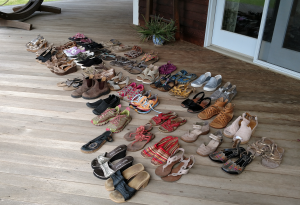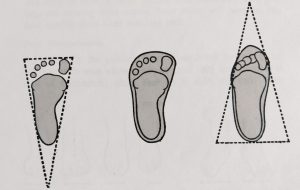 Recently I had the daring motivation to take an inventory of my shoes. I had somewhat taken pride in thinking my collection was minimal and conservative, but I was wrong. The count was about 50 pair, and of those I only wore about 4 or 5 on a regular basis– and I had more on order. I decided to take another look at why I had obsession with shoes and found I was in a perpetual search for a comfortable and attractive shoe, hence the need to keep looking. How fitting for the shoe industry who must be elated with this common phenomenon. After thinking about my shoe potpourri, I realized it was a never ending quest because the manufactured shoe design is imperfect for most feet.
Recently I had the daring motivation to take an inventory of my shoes. I had somewhat taken pride in thinking my collection was minimal and conservative, but I was wrong. The count was about 50 pair, and of those I only wore about 4 or 5 on a regular basis– and I had more on order. I decided to take another look at why I had obsession with shoes and found I was in a perpetual search for a comfortable and attractive shoe, hence the need to keep looking. How fitting for the shoe industry who must be elated with this common phenomenon. After thinking about my shoe potpourri, I realized it was a never ending quest because the manufactured shoe design is imperfect for most feet.
Shoes are a big deal–and their comfort and design should be carefully considered because wearing one style over another may or may not be beneficial to the feet and body. Just today after reading my book, Put Your Best Feet Forward, my 80 something year old neighbor called to say he was going shoe shopping and would like me to measure his feet. He explained that his thighs seemed exceptionally tight and his toes cramp alot. Suspecting he was wearing the wrong size shoe, he found a larger size and since making a change to a bigger shoe his thighs are now more relaxed–but he wanted to make sure everything was right.
Sure enough the shoes he had previously been wearing were not the correct size and the toe-box tapered to a soft “V” which forced his fore-foot and toes to fold in the shoe. Consequently, the lower leg muscles that attach to and move the foot were bowing with strain making function and weight bearing awkward and difficult. The responsibility of foot movement defaulted to his thigh muscles and other parts of his body, which is not their function, and soon they fatigued from this burden. After measuring his feet I was happy to tell him he had chosen a shoe that fit both the size and shape of his foot. Proudly, he said in his Vermont drawl “Well, I guess I did something right.”
Simon J. Wikler, doctor of surgical podiatry designed the Wikler Shoe by Buster Brown after decades of experience in working with problematic feet. He realized the typical shoe design was all wrong and in fact was made quite oppositely to the way feet are actually shaped. He drew a simple triangle to explain this analogy which showed that most shoes are designed with the point of the triangle at the toe-box (top of the triangle) and the wider part of the triangle toward the heel. He asserted that the anatomical design of the foot would perform better in a shoe with the point of the triangle at the heel and the wider part in the forefoot.

Dr Wikler’s triangle and description below:
Left image: Toes are widest part of a normal foot and roughly form face of triangle with apex at heel. Middle image: Non-deforming shoe. Right image: Modern shoes cause toes to be pointed and narrower than heel, and distort normal shape.
What types of shoes are best?
Here are some guidelines to go by when choosing a functional shoe:
Flexibility– The more flexible the shoe the more the foot receives beneficial exercise. Rigid shoes limit the foots’ ability to adapt because it immobilizes the joints of the foot and inhibits the natural springing function of the arch–and this makes the muscles that move the foot very confused. Some of my favorite shoes for men and women are Altra, Topo, Ahnu, Olukai, Ash, J-Slides, Born, Rieker, Xero, and Vans.
Shape– The shape of the shoe should match the shape of the foot.
Security– Shoes should tie or fit securely onto the foot, have a heel on the back of the shoe, or a heel strap to prevent the toes from having to manage the shoe.
What is your shoe collection like? Is your body communicating sites of tension because of your shoe choices?
Archives
- October 2024
- December 2023
- October 2023
- March 2022
- July 2021
- August 2020
- May 2020
- April 2020
- February 2020
- January 2020
- December 2019
- November 2019
- October 2019
- August 2019
- June 2019
- May 2019
- April 2019
- January 2019
- December 2018
- October 2018
- September 2018
- July 2018
- June 2018
- April 2018
- February 2018
- December 2017
- November 2017
- October 2017
- September 2017
- August 2017
- July 2017
- June 2017
- May 2017
- April 2017
- February 2017


